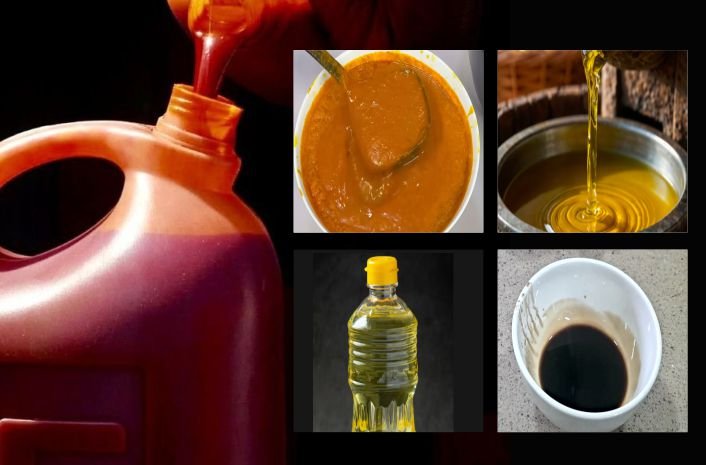Red palm oil vs palm oil, one is a specific nutrient-rich type, the other an umbrella term for five oils. Understanding this distinction can shift your choices in health and cooking.
Red palm oil vs palm oil can leave you scratching your head. You’ve probably seen both terms on labels, in recipes, or health blogs, but they’re not the same thing.
Palm oil is a broad term used for five different oils that come from the oil palm fruit, and red palm oil is just one of them.
This mix-up causes real confusion, especially when you’re trying to eat healthier or understand what’s in your food.
If you’ve ever wondered why some oils are golden and others bright red, or why some are praised for nutrients while others get a bad rap, you’re not alone.
Knowing what sets red palm oil apart from the rest helps you choose wisely, cook better, and stay informed.
Let’s sort through the noise so you can shop and eat with clarity.
Related: Cooking with Red Palm Oil
Table of Contents
- Understanding the Umbrella Term: What is Palm Oil?
- What Sets Red Palm Oil Apart?
- Comparing Red Palm Oil with Other Palm Oils
- Conclusion
- Frequently Asked Questions
Understanding the Umbrella Term: What is Palm Oil?
Palm oil refers to five different oils from the oil palm fruit. Each oil has its own unique qualities and uses, and understanding these differences helps you make more informed choices.
Crude Palm Oil: Extracted Straight from the Fruit
You get crude palm oil from the flesh of the oil palm fruit. It has a deep, reddish color because it retains its natural beta carotene.
This oil is thick and full-bodied and is mainly used in cooking and food processing in its raw state or as a base for refining.
Its nutrient content stays intact before it’s processed further into refined oils or turned into red palm oil for direct use.
Red Palm Oil: Minimal Processing, Maximum Nutrients
Red palm oil is what you get when crude palm oil is processed gently without stripping it of its nutrients.
You still see that bright red color, and you get the antioxidants, beta carotene, and vitamin E that crude palm oil contains.
If you’re looking for palm oil that’s close to nature and still good for cooking, this is the one.
It’s common in African and Southeast Asian kitchens and valued for both nutrition and flavor.
Refined Palm Oil: Neutral Oil for Everyday Use
Refined palm oil goes through bleaching and deodorizing. That means it loses its color, smell, and some of its nutrients.
What you’re left with is a neutral oil that works well in processed foods, snacks, and fast food.
It’s light in color and doesn’t change the taste of what you’re cooking.
This version is the most common in the global market and shows up in everything from baked goods to frozen meals.
Refined Palm Kernel Oil: A Different Oil from the Same Fruit
Palm kernel oil is not the same as the oil you get from the flesh of the fruit.
This one comes from the seed or kernel inside the fruit. It has more saturated fats and behaves more like coconut oil.
When refined, you get the refined palm kernel oil.
You’ll find it in commercial baking, non-dairy creamers, and even personal care products.
It gives products a longer shelf life and adds a creamy texture to baked goods and spreads.
Crude Palm Kernel Oil: Raw but Powerful
Crude palm kernel oil is the unrefined version of palm kernel oil. It’s still full of nutrients and has a higher level of lauric acid, which helps with cleaning and foaming.
That makes it useful in soap making and detergents.
While it’s not used as much in direct cooking, its raw form plays a major role in manufacturing and industrial use.
You’ll likely see it in ingredient lists on cosmetics and body care items.
Related Posts
Best Alternatives for Red Palm Oil
Nutritional Value of Red Palm Oil
The Reasons Why Red Palm Oil is African Chefs’ Darling
What Sets Red Palm Oil Apart?
You might have seen red palm oil in stores or local markets and wondered why it looks so different from the usual palm oil you know.
Here’s what sets it apart.
Color That Comes With Nutrition: Carotenoids in Action
The deep red color comes from carotenoids like beta carotene.
These natural compounds support your eyes, skin, and immune system.
Red palm oil has more carotenoids than carrots or tomatoes, making it one of the richest natural sources of provitamin A your body can easily convert and use every day.
Minimal Processing Means More Nutrients for You
Red palm oil goes through less refining, so its nutrients stay intact. You still get tocotrienols, a rare form of vitamin E, and helpful antioxidants.
These compounds support brain function and help your body resist daily stress. If you want a cooking oil that feeds more than hunger, this one delivers.
Antioxidants That Support Everyday Health
Red palm oil gives your meals more than flavor. It’s packed with antioxidants that help protect your cells from damage.
These compounds are linked to better heart health, stronger immunity, and slower aging.
Using this oil regularly means you’re feeding your body natural tools to stay balanced and feel well.
Related: Benefits of Red Palm Oil for Hair
Aroma and Taste That Bring Dishes to Life
This oil adds a rich, buttery aroma and a warm taste that lifts your cooking. It pairs well with soups, stews, and greens.
Because it handles heat without breaking down, it’s great for frying and slow cooking.
Traditional kitchens have relied on it for both flavor and strength in meals.
Comparing Red Palm Oil with Other Palm Oils
Red palm oil stands out among the five oils that come from the oil palm fruit.
Each oil has its place, but knowing how they differ helps you use them more wisely.
Red Palm Oil vs Crude Palm Oil: Same Fruit, Different Purpose
Both oils come from the flesh of the oil palm fruit, but red palm oil is processed to keep its color and nutrients.
Crude palm oil, while less refined, still loses some value when used in bulk production.
If you care about antioxidants and vitamin A, red palm oil gives you more.
Crude palm oil is mostly neutral and often ends up in further processing before it hits your plate.
Related: How Does Batana Oil and Red Palm Oil Relate?
Red Palm Oil vs Refined Palm Oil: Nutrition or Neutrality
Refined palm oil looks pale and has no scent because it’s been stripped of color and flavor. This makes it common in packaged foods and snacks.
Red palm oil keeps its nutrients and bold taste because it’s not stripped down.
If you’re after health benefits like tocotrienols and carotenoids, red palm oil is your better choice in the kitchen.
Red Palm Oil vs Palm Kernel Oil: Different Parts of the Fruit
Palm kernel oil comes from the seed inside the palm fruit, not the outer flesh. It’s high in saturated fats and behaves more like coconut oil.
You’ll find it in candy, baked goods, and soap. It doesn’t offer the nutrients or deep color of red palm oil.
If your goal is nutrition, red palm oil gives more than just cooking fat.
Red Palm Oil vs Crude Palm Kernel Oil: Raw but Not the Same
Crude palm kernel oil is the unrefined version of palm kernel oil. It keeps more of its natural state, but still lacks the nutrients red palm oil offers.
While it works well in soap-making and some industrial uses, it rarely competes with red palm oil in your meals.
Red palm oil’s color, nutrients, and taste make it more useful in everyday cooking.
Conclusion
Red palm oil vs palm oil, one is a specific nutrient-rich type, the other an umbrella term for five oils.
Understanding this distinction can shift your choices in health and cooking.
Red palm oil gives you antioxidants, flavor, and a natural source of vitamins, while most commercial palm oils go through processing that strips them down.
Now that you know the difference, you can read labels more clearly, choose oils that support your goals, and cook with purpose.
From food prep to product labels, what you know now will shape what goes into your kitchen.
Make your choices count and let your meals reflect knowledge, care, and better ingredients every time.
Frequently Asked Questions
Is red palm oil better than regular palm oil?
Red palm oil retains more nutrients like carotenoids and vitamin E due to less processing. It offers better health value than highly refined palm oils used in processed foods.
Can I cook with red palm oil instead of palm oil?
Yes, you can. Red palm oil works well for frying, sautéing, and stews. It has a stronger flavor and color but holds up well under heat without breaking down.
Why is red palm oil red while other palm oils are not?
The red color comes from high levels of carotenoids like beta carotene, which are removed during the refining process used in producing most other palm oil types.
Is red palm oil the same as crude palm oil?
No. Red palm oil is a gently processed version of crude palm oil. It keeps more nutrients, while crude palm oil is usually refined further for commercial use.
I am Chimeremeze, a writer and researcher with deep-rooted experience in processing, consuming, and utilizing locally produced palm oil products, including red palm oil, palm kernel oil, and refined palm oil. Growing up in a community surrounded by towering palm trees, we embraced every part of this nature’s gift—drinking its wine, using the fronds for fencing, crafting brooms from its leaves, and turning its sturdy trunks into communal benches.
My passion for the palm tree and its countless benefits drives my research and writing, shedding light on its significance to West Africa and beyond. I also explore the impact of cassava, another staple crop that has shaped Africa and influenced the world.

